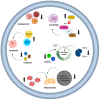Third-Generation Tetracyclines: Current Knowledge and Therapeutic Potential
- PMID: 39062497
- PMCID: PMC11275049
- DOI: 10.3390/biom14070783
Third-Generation Tetracyclines: Current Knowledge and Therapeutic Potential
Abstract
Tetracyclines constitute a unique class of antibiotic agents, widely prescribed for both community and hospital infections due to their broad spectrum of activity. Acting by disrupting protein synthesis through tight binding to the 30S ribosomal subunit, their interference is typically reversible, rendering them bacteriostatic in action. Resistance to tetracyclines has primarily been associated with changes in pump efflux or ribosomal protection mechanisms. To address this challenge, tetracycline molecules have been chemically modified, resulting in the development of third-generation tetracyclines. These novel tetracyclines offer significant advantages in treating infections, whether used alone or in combination therapies, especially in hospital settings. Beyond their conventional antimicrobial properties, research has highlighted their potential non-antibiotic properties, including their impact on immunomodulation and malignancy. This review will focus on third-generation tetracyclines, namely tigecycline, eravacycline, and omadacycline. We will delve into their mechanisms of action and resistance, while also evaluating their pros and cons over time. Additionally, we will explore their therapeutic potential, analyzing their primary indications of prescription, potential future uses, and non-antibiotic features. This review aims to provide valuable insights into the clinical applications of third-generation tetracyclines, thereby enhancing understanding and guiding optimal clinical use.
Keywords: eravacycline; immunomodulation; malignancy; mechanism of action; non-antibiotic properties; omadacycline; resistance; tetracyclines; tigecycline.
Conflict of interest statement
The authors declare no conflicts of interest.
Figures





Similar articles
-
In Vitro Antimicrobial Activities of Tigecycline, Eravacycline, Omadacycline, and Sarecycline against Rapidly Growing Mycobacteria.Microbiol Spectr. 2023 Feb 14;11(1):e0323822. doi: 10.1128/spectrum.03238-22. Epub 2022 Dec 8. Microbiol Spectr. 2023. PMID: 36475850 Free PMC article.
-
In vitro antimicrobial activity and resistance mechanisms of the new generation tetracycline agents, eravacycline, omadacycline, and tigecycline against clinical Staphylococcus aureus isolates.Front Microbiol. 2022 Nov 22;13:1043736. doi: 10.3389/fmicb.2022.1043736. eCollection 2022. Front Microbiol. 2022. PMID: 36483205 Free PMC article.
-
Re-establishing the utility of tetracycline-class antibiotics for current challenges with antibiotic resistance.Ann Med. 2022 Dec;54(1):1686-1700. doi: 10.1080/07853890.2022.2085881. Ann Med. 2022. PMID: 35723082 Free PMC article. Review.
-
Omadacycline: A Novel Oral and Intravenous Aminomethylcycline Antibiotic Agent.Drugs. 2020 Feb;80(3):285-313. doi: 10.1007/s40265-020-01257-4. Drugs. 2020. PMID: 31970713 Review.
-
Novel Tet(L) Efflux Pump Variants Conferring Resistance to Tigecycline and Eravacycline in Staphylococcus Spp.Microbiol Spectr. 2021 Dec 22;9(3):e0131021. doi: 10.1128/Spectrum.01310-21. Epub 2021 Dec 8. Microbiol Spectr. 2021. PMID: 34878306 Free PMC article.
Cited by
-
Tiny but Mighty: Small RNAs-The Micromanagers of Bacterial Survival, Virulence, and Host-Pathogen Interactions.Noncoding RNA. 2025 May 5;11(3):36. doi: 10.3390/ncrna11030036. Noncoding RNA. 2025. PMID: 40407594 Free PMC article. Review.
-
Eravacycline: evaluation of susceptibility testing methods and activity against multidrug-resistant Enterobacterales and Acinetobacter.Eur J Clin Microbiol Infect Dis. 2025 Aug 18. doi: 10.1007/s10096-025-05235-0. Online ahead of print. Eur J Clin Microbiol Infect Dis. 2025. PMID: 40824337
-
Staphylococcus aureus: A Review of the Pathogenesis and Virulence Mechanisms.Antibiotics (Basel). 2025 May 6;14(5):470. doi: 10.3390/antibiotics14050470. Antibiotics (Basel). 2025. PMID: 40426537 Free PMC article. Review.
-
Evaluation of the Potential of Metal-Organic Compounds ZIF-8 and F300 in a Membrane Filtration-Adsorption Process for the Removal of Antibiotics from Water.Antibiotics (Basel). 2025 Jun 18;14(6):619. doi: 10.3390/antibiotics14060619. Antibiotics (Basel). 2025. PMID: 40558209 Free PMC article.
-
Design and Application of an Imprinted Polymer Sensor for the Dual Detection of Antibiotic Contaminants in Aqueous Samples and Food Matrices.ACS Appl Polym Mater. 2025 Feb 19;7(4):2265-2273. doi: 10.1021/acsapm.4c03218. eCollection 2025 Feb 28. ACS Appl Polym Mater. 2025. PMID: 40046615 Free PMC article.
References
Publication types
MeSH terms
Substances
LinkOut - more resources
Full Text Sources
Medical
Miscellaneous

